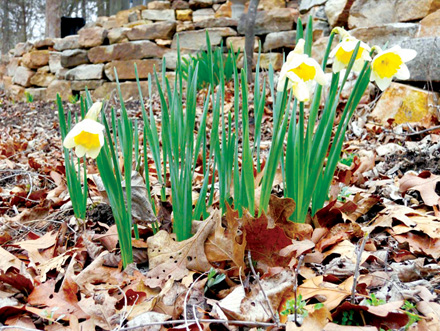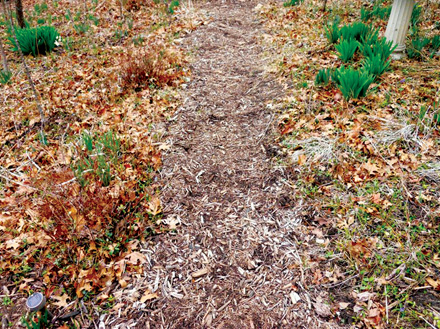Much on Mulch

When to add mulch can be confusing so first decide why you want to mulch. The reason will direct the kind of mulch to use, as well as when to apply it.
When thinking of mulch, there are basically two kinds: organic and inorganic.
Organic mulches are readily available in most gardens: leaves, grass clippings, compost, shredded bark and tree limbs. You may have to purchase other organic mulches such as straw. You can also make, and buy compost, and collect paper.
Inorganic mulch includes plastic, gravel and landscape fabric.
Why mulch? Oh, my, so many reasons including weed control, to maintain soil moisture, to amend soil, to keep plants warm, to keep plants cold, to finish garden area, to build up soil. In general, mulch after the garden reaches the condition you want to maintain.
For best weed control, remove weeds before mulching and add a thick four to six inch layer of mulch in full sun to discourage new weeds from coming up. I like to add a layer of cardboard or newspaper before adding mulch; the paper products prevent light from getting through and also suppress weed growth. When in shade, I only make the mulch two to three inches thick but I still use cardboard or newspaper underneath.
To retain moisture and reduce weeds, I combine wood chips and leaves.
I first cover flowerbeds with a blanket of leaves, then after a good rain cover the leaves with three to six inches of weathered wood chips. The leaves help to keep the soil moist and discourage weeds from germinating. The few that do are easy to pull out. Both leaves and wood chips decompose slowly, releasing nutrients into the soil.
I do periodically check that perennials are coming through and that the wood chip layer isn’t too thick. I also tap the leaves down around the larger plants and make sure they are not touching before adding wood chips.
Leaves and wood chips are good tree mulches. Make a well around the tree trunk to capture water and leave the chips in a ring around the edge to hold water in.
For vegetable gardens, grass clippings are a good mulch because the grass clippings add nitrogen to vegetable garden soil. Be careful of mulching with compost, I prefer to mix compost into soil instead of leaving it on top. Compost can burn newly emerging seedlings.
If you want to use straw, make sure it is from a good source without seeds or you will have more unwanted plants growing.
Black plastic mulch is good to keep soil warm and radiate heat during the night. Black plastic keeps heat-loving vegetables such as cherry tomatoes and eggplants tucked in nicely.
Landscape fabrics are expensive but can work well in areas where you don’t want to spend time weeding and don’t have time to regularly maintain. Clear plastic covered in gravel will also easily keep weeds from growing.
Ask any landscaper what their secret to finishing off a garden project is and they will say mulch!
Charlotte Ekker Wiggins is a beekeeper, gardener and sometimes cook. Published by El Dorado Springs Sun once in print and online with author’s permission. Copyright 2017, all rights reserved. This column may not be reprinted, republished or otherwise distributed without author’s permission. Contact Charlotte at gardeningcharlotte@gmail.com.

WOULDN’T YOU KNOW IT? – Thick wood chips not only can mulch flower beds but also make comfortable walking paths.

EASY AND NATURAL – Dry leaves make nice mulch under wood chips in flower beds. (Photos by Charlotte Ekker Wiggins).



Facebook Comments